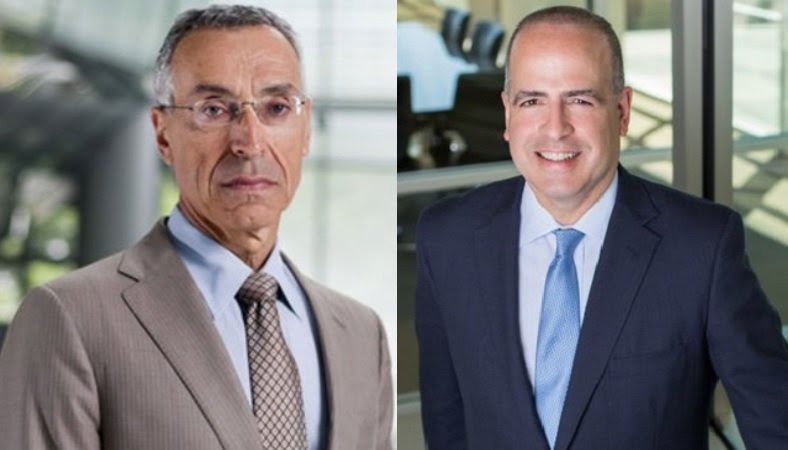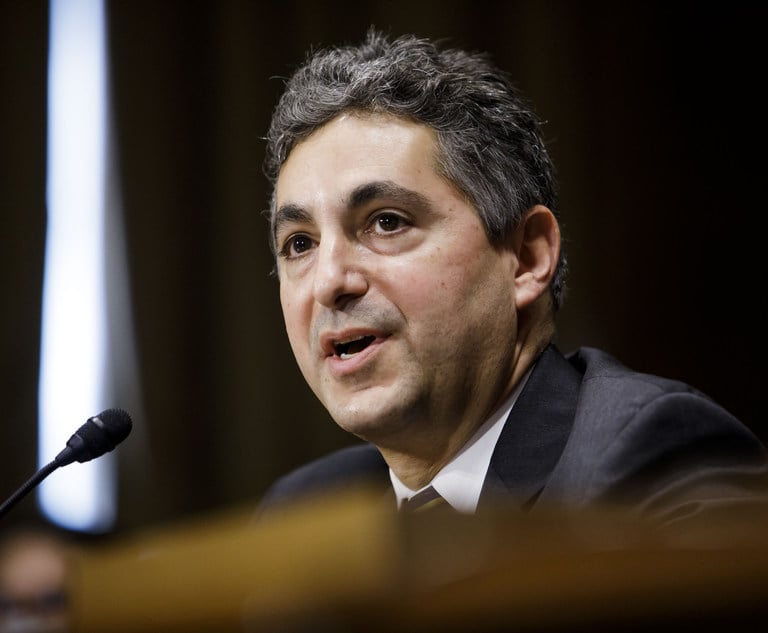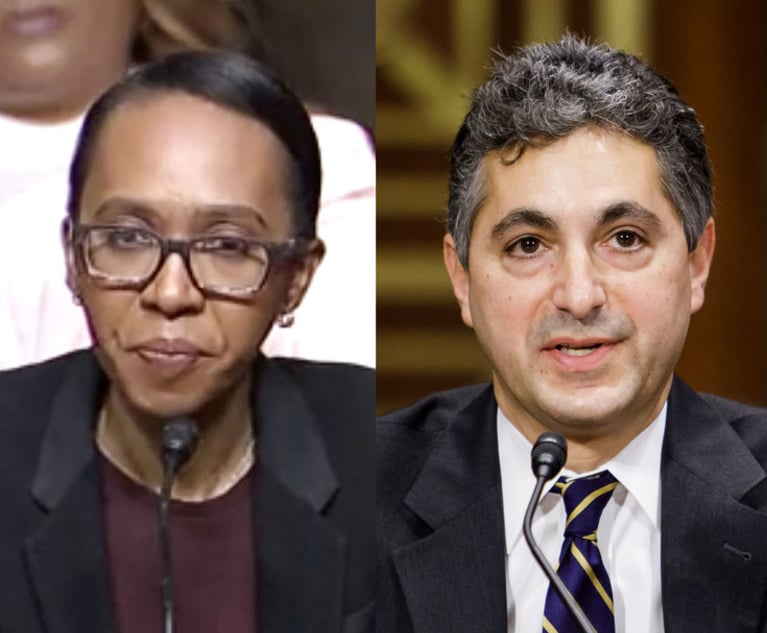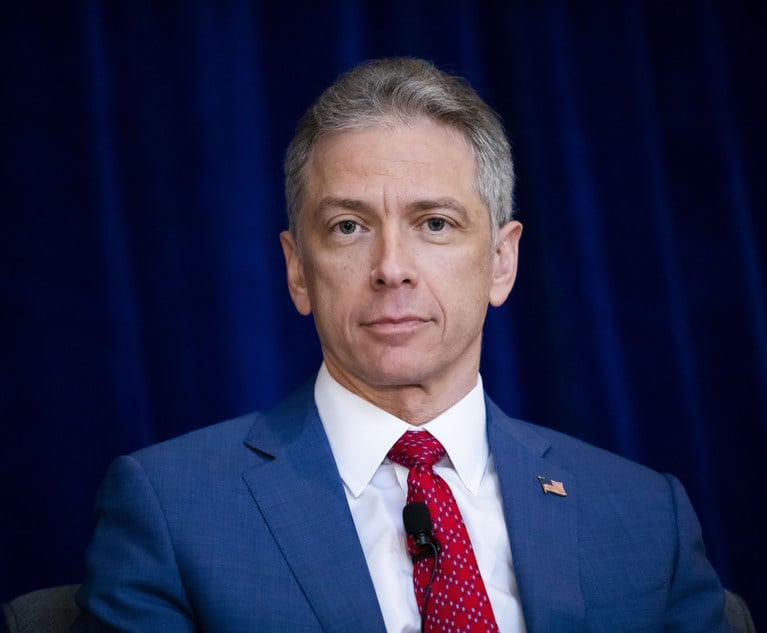Skilled in the Art: Supreme Court Can CVSG but It Can't Hide From Section 101 + A PTAB Precedent, If You Can Keep It
The Supreme Court is definitely going to weigh in again soon on Section 101, maybe.
December 10, 2019 at 09:57 PM
10 minute read
Welcome to Skilled in the Art. I'm Law.com IP reporter Scott Graham. A few months ago, it looked like we might have a busy but somewhat snoozy term for IP at the Supreme Court. Now, the justices have taken on Google v. Oracle, and the solicitor general is clamoring for them to grant certiorari in a Section 101 case, though not right away. So let's get to it:
• Solicitor general urges Supreme Court to take up a Section 101 case, though not either of the two the court asked them about.
• The ends justify the means when it comes to AIA time bar appeals and bad patents, judging from Supreme Court questioning.
• Barnes & Thornburgh adds nine IP partners, opens three new offices.
As always, you can email me your feedback and follow me on Twitter.
 Future Supreme Court Section 101 Faceoff? WilmerHale's Seth Waxman (left) and Fish & Richardson's Jonathan Singer, counsel of record in Athena Diagnostics v. Mayo
Future Supreme Court Section 101 Faceoff? WilmerHale's Seth Waxman (left) and Fish & Richardson's Jonathan Singer, counsel of record in Athena Diagnostics v. Mayo
Somebody Should Fix Section 101, Someday
The Supreme Court is definitely going to weigh in again soon on Section 101, maybe. A patent eligibility case could be heading to the court any day. Or maybe next year, or a few years from now. Either before or after the Senate IP subcommittee does or does not introduce a Section 101 amendment.
Last January—as in 11-months-ago January—the Supreme Court asked the solicitor general's office whether the court ought to take up Berkheimer v. HP. That decision holds that eligibility can sometimes turn on subsidiary fact questions that can't be resolved on the pleadings. It's caused gnashing of teeth both within the Federal Circuit and at district courts.
On Friday, we got our answer: The Supreme Court's recent decisions on patent eligibility "have introduced substantial uncertainty regarding the proper Section 101 inquiry," states the brief, which is signed by Solicitor General Noel Francisco, PTO Solicitor Thomas Krause, and other DOJ and PTO leadership.
So let's grant cert in Berkheimer and resolve this mess, right?
No, taking up Berkheimer would be "premature," the SG says. First the court needs to clear up the substantive standards for deciding eligibility. Whether eligibility is a legal, factual, or hybrid inquiry, and who should determine it, "would be difficult to answer in any cogent manner while uncertainty about the substance of the Section 101 inquiry persists," the brief states.
As McDonnell Boehnen Hulbert & Berghoff partner Michael Borella puts it on the firm's Patent Docs blog, "The Solicitor General appears to be taking the position that there is little point to apply a Berkheimer band-aid when patent-eligibility actually needs major surgery."
OK, well how about Hikma Pharamceuticals USA v. Vanda Pharmaceuticals, a Section 101 case in which the high court requested the SG's views last March?
Hikma likewise "implicates important and recurring questions on which the Court's recent Section 101 decisions have fostered substantial uncertainty," the SG states in a brief also filed Friday. Many method-of-treatment patents, including the one at issue in Hikma, could be wiped out if the courts were to "mechanically" apply the high court's 2012 eligibility precedent Mayo v. Prometheus, the SG warns.
"This case, however, is not an optimal vehicle for bringing greater clarity because the court of appeals majority arrived at the correct result" and preserved the patent in Hikma, the SG states.
Borella says the briefs reflect the brashness of the Trump administration. You have "two clear swipes at the judiciary: 'You screwed up the law' and 'you are not qualified to fix it,'" he writes.
But the SG does have its sights set on another Section 101 case for the Supreme Court: Athena Diagnostics v. Mayo Collaborative Services, a medical diagnostics case that should be up for a cert vote early next year.
"Mayo [v. Prometheus] has had particularly significant practical effects with respect to medical-diagnostic methods," the SG states (i.e. numerous patents killed). And all 12 active Federal Circuit judges signed onto eight opinions in Athena stating that the Supreme Court or Congress ought to rethink eligibility law, at least as it applies to diagnostics.
Is it a little risky for the SG to suggest that leaving Mayo alone could result in invalidation of method-of-use patents? "I don't think it's a huge gambit," Villanova law professor Michael Risch says. "Mayo is pretty clear that it doesn't mean to wipe out all new drug use method patents, and yet (with some exceptions) courts seem to be using Mayo to wipe out all new drug use method patents."
Christian Liedtke of Acuminis says those Federal Circuit opinions could push Athena over the top. "Everyone and their mother has something to say" in that case, he said. "The Federal Circuit has basically teed it up for the Supreme Court."
If the court ultimately goes with Athena, it could pit former Solicitor General Seth Waxman, now at Wilmer Cutler Pickering Hale and Dorr and counsel of record for Athena Diagnostics, versus Fish & Richardson partner Jonathan Singer, who is counsel of record for Mayo Collaborative Services and was part of Mayo's team in the 2012 Supreme Court win.

Supreme Court Still Not a Fan of Patents (In Case There Was Any Doubt)
It's become fashionable even in pro-patent circles to suggest that the Federal Circuit has outlived its utility. Some patentees see the court as having gone over to the accused-infringer dark side.
I would commend to them Monday's Supreme Court arguments in Thryv v. Click-to-Call Technologies. Unlike the Federal Circuit, which has assumed the burden of painstakingly setting out rules for timely filing of IPR challenges and determining real parties in interest, the Supreme Court's attitude seems to be: "Who cares?"
The AIA says no appeals can be taken from decisions to institute IPR proceedings, though patent owners say that can't mean the PTO is free to ignore explicit AIA rules on timeliness. But what does it matter, the justices suggested Monday, if a bad patent is going to end up invalidated anyway?
"We go through the entire process, soup to nuts, and then we get to the end and somebody says, you know, the time bar wasn't applied correctly," Justice Elena Kagan said. "We throw it all out and we start all over again on something that we know by now is an invalid patent."
To Kagan and a couple other justices, that's apparently crazy talk.
"What's so terrible" about strictly interpreting the appeal bar, Justice Stephen Breyer asked. "After all, the director could do this on his own [through an] ex parte reexamination." Never mind that ex parte reexamination is quite different from IPR and comes with its own set of patent owner protections.
"There's something unseemly about nullifying the determination on the merits," said Justice Ruth Bader Ginsburg.
Daniel Geyser of Geyser P.C. argued that the time bar is "not a minor statutory technicality" but "a significant protection for patent owners."
The vote may be close, but it didn't sound to me as if Geyser will sway the justices. If that's how it works out, Matthew Dowd of Dowd Scheffel is among those who won't be happy.
"Rarely does the Court adopt a 'no harm, no foul' approach when it comes to an agency overstepping its statutory authority—except apparently in the patent context," he wrote on Twitter.

A PTAB Precedent, If You Can Keep It
Ropes & Gray partner Matt Rizzolo points out there is a difference when it comes to the PTAB and the time bar. Section 314(d) of the AIA does, after all, say "NO APPEAL—The determination by the Director whether to institute an inter partes review under this section shall be final and nonappealable."
That does seem pretty straightforward.
The other side of that argument is the Supreme Court has already interpreted this provision twice and each time left some wiggle room. Breyer wrote in Cuozzo v. Lee that the appeal bar would not "enable the agency to act outside its statutory limits." Justice Neil Gorsuch emphasized that holding in SAS v. Iancu: "Cuozzo concluded that Section 314(d) precludes judicial review only of the Director's 'initial determination' under Section 314(a) that 'there is a "reasonable likelihood" that the claims are unpatentable on the grounds asserted,'" Gorsuch wrote. "Nothing in Section 314(d) or Cuozzo withdraws our power to ensure that an inter partes review proceeds in accordance with the law's demands."
It's going to be fun to see how the justices pretzel their way out of these precedents if they now take a harder line. The justices were clearly aware of the problem during Monday's arguments.
"What do you do with the sentence in this Court's SAS decision that says 314(d) precludes judicial review only of the Board's initial determination under 314(a)?" Ginsburg asked Kilpatrick Townsend & Stockton partner Adam Charnes, representing petitioner Thryv Inc.
"We think that that's not a complete description of Cuozzo," Charnes said, because the rationale for judicial review in SAS "was completely different."
"I think you are saying it's wrong, to pick up on Justice Ginsburg's question, at least the use of the word 'only,'" Justice Brett Kavanaugh said.
Assistant to the Solicitor General Jonathan Ellis fessed up on behalf of the PTO. "I do think that sentence [in SAS] is wrong, and I think it's incomplete," he said. But it's not a problem, Ellis said, because appealability "just wasn't at issue in SAS."
Paul Hastings partner Igor Timofeyev, who observed Monday's arguments, said he believes the justices approached the issue through the prism of their general view on judicial reviewability of agency decisions.
"Thus, Justices Gorsuch and Alito—who favor tighter limits on agencies' discretion—seemed inclined to hold that courts should review the PTO's compliance with the time-bar requirement. By contrast, Justices Kagan and Breyer, who give agencies wider leeway, viewed as sufficient that courts review the PTAB's ultimate determination of unpatentability, and trust the PTO to administer its own compliance with the time bar."
IP Laterals – Barnes & Thornburg
My American Lawyer colleagues last week broke the news that Barnes & Thornburg has added a nine-partner life sciences team from Brinks Gilson & Lione and launched new offices in Raleigh, Ann Arbor and Salt Lake City.
The group is led by Allen Baum, who's been based in Raleigh-Durham for more than 20 years, and William R. Boudreaux in Ann Arbor. A number of the group members have advanced degrees in organic chemistry, molecular biology, chemistry and biotechnology.
"This really expands and deepens our national life sciences practice," said Barnes & Thornburg managing partner Robert T. Grand. "These guys are bringing decades of experience."
Baum's Raleigh-based team also includes Bashir Ali, Amy Fix, Aisha Hasan and Mark Jenkins. The other new partners are Eric Babych and Ryan Marshall, who will work from Salt Lake City, and Heidi Dare, who joins Barnes & Thornburg's Chicago office. The group also includes an associate, two patent agents, an IP technical analyst and four paralegals.
That's all from Skilled in the Art today. I'll see you all again on Friday.
This content has been archived. It is available through our partners, LexisNexis® and Bloomberg Law.
To view this content, please continue to their sites.
Not a Lexis Subscriber?
Subscribe Now
Not a Bloomberg Law Subscriber?
Subscribe Now
NOT FOR REPRINT
© 2025 ALM Global, LLC, All Rights Reserved. Request academic re-use from www.copyright.com. All other uses, submit a request to [email protected]. For more information visit Asset & Logo Licensing.
You Might Like
View All
Skilled in the Art With Scott Graham: I'm So Glad We Had This Time Together

Design Patent Appeal Splinters Federal Circuit Panel + Susman Scores $163M Jury Verdict + Finnegan Protects Under Armour's House
Law Firms Mentioned
Trending Stories
- 1Delaware Supreme Court Names Civil Litigator to Serve as New Chief Disciplinary Counsel
- 2Inside Track: Why Relentless Self-Promoters Need Not Apply for GC Posts
- 3Fresh lawsuit hits Oregon city at the heart of Supreme Court ruling on homeless encampments
- 4Ex-Kline & Specter Associate Drops Lawsuit Against the Firm
- 5Am Law 100 Lateral Partner Hiring Rose in 2024: Report
Who Got The Work
J. Brugh Lower of Gibbons has entered an appearance for industrial equipment supplier Devco Corporation in a pending trademark infringement lawsuit. The suit, accusing the defendant of selling knock-off Graco products, was filed Dec. 18 in New Jersey District Court by Rivkin Radler on behalf of Graco Inc. and Graco Minnesota. The case, assigned to U.S. District Judge Zahid N. Quraishi, is 3:24-cv-11294, Graco Inc. et al v. Devco Corporation.
Who Got The Work
Rebecca Maller-Stein and Kent A. Yalowitz of Arnold & Porter Kaye Scholer have entered their appearances for Hanaco Venture Capital and its executives, Lior Prosor and David Frankel, in a pending securities lawsuit. The action, filed on Dec. 24 in New York Southern District Court by Zell, Aron & Co. on behalf of Goldeneye Advisors, accuses the defendants of negligently and fraudulently managing the plaintiff's $1 million investment. The case, assigned to U.S. District Judge Vernon S. Broderick, is 1:24-cv-09918, Goldeneye Advisors, LLC v. Hanaco Venture Capital, Ltd. et al.
Who Got The Work
Attorneys from A&O Shearman has stepped in as defense counsel for Toronto-Dominion Bank and other defendants in a pending securities class action. The suit, filed Dec. 11 in New York Southern District Court by Bleichmar Fonti & Auld, accuses the defendants of concealing the bank's 'pervasive' deficiencies in regards to its compliance with the Bank Secrecy Act and the quality of its anti-money laundering controls. The case, assigned to U.S. District Judge Arun Subramanian, is 1:24-cv-09445, Gonzalez v. The Toronto-Dominion Bank et al.
Who Got The Work
Crown Castle International, a Pennsylvania company providing shared communications infrastructure, has turned to Luke D. Wolf of Gordon Rees Scully Mansukhani to fend off a pending breach-of-contract lawsuit. The court action, filed Nov. 25 in Michigan Eastern District Court by Hooper Hathaway PC on behalf of The Town Residences LLC, accuses Crown Castle of failing to transfer approximately $30,000 in utility payments from T-Mobile in breach of a roof-top lease and assignment agreement. The case, assigned to U.S. District Judge Susan K. Declercq, is 2:24-cv-13131, The Town Residences LLC v. T-Mobile US, Inc. et al.
Who Got The Work
Wilfred P. Coronato and Daniel M. Schwartz of McCarter & English have stepped in as defense counsel to Electrolux Home Products Inc. in a pending product liability lawsuit. The court action, filed Nov. 26 in New York Eastern District Court by Poulos Lopiccolo PC and Nagel Rice LLP on behalf of David Stern, alleges that the defendant's refrigerators’ drawers and shelving repeatedly break and fall apart within months after purchase. The case, assigned to U.S. District Judge Joan M. Azrack, is 2:24-cv-08204, Stern v. Electrolux Home Products, Inc.
Featured Firms
Law Offices of Gary Martin Hays & Associates, P.C.
(470) 294-1674
Law Offices of Mark E. Salomone
(857) 444-6468
Smith & Hassler
(713) 739-1250










